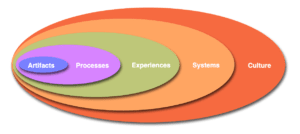Research: Education by Design
The idea of design

Design is core to my identity, to who I am. Education is the space within which I function but I try to approach everything I do as a designer.
Herb Simon, in his book, The Sciences of the Artificial, famously wrote:
Everyone designs who devises courses of action aimed at changing existing situations into preferred ones.
In one fell swoop, Simon situated design as playing a role across a range of human-centered professions, whether it be graphic design, architecture, medicine, or social policy.
And most relevant to us: Education.
Which is why I prefer to call myself an educational designer (rather than educational researcher). I see the world through the lens of design. Everything in the world around me, education, parenting, research, to me are enriched by taking on this perspective: a design lens as it were.
It is no surprise, thus, that one of my favorite courses I teach is called Education by Design. The course intro is as follows:
DCI 691 (Education by Design) is a course about design. Design as a way of thinking and as a process that values collaboration, context, and diverse perspectives. Design as an approach that generates creative solutions to complex (wicked) problems of practice, particularly in education.
Design is both a noun and a verb, a product and a process. Design is central to the construction of any process or artifact—be it a website or a car; an ATM machine or educational policy. Design touches on many different disciplines—science, technology, engineering, education, psychology, sociology, organizational behavior, and art, to name a few. A multi-dimensional issue like design, particularly in education, requires a multifaceted approach.
for The 5 spaces for design in education

Everything in education is designed (one can argue whether this is intentional or not or whether the outcomes are the ones we want/like) but the broader point is that there is nothing “natural” about the systems of education we have around us. They are constructed by us, by humans. Whether the idea of the curriculum or seat-time, learning metrics or the idea of problem-based learning, or the idea of school, these are all human creations, structures adapted for some purpose (to quote Perkins and his definition of design).
That said, there is something fundamentally different about designing a textbook v.s. a chair; or designing a school v.s. designing an instructional plan. The differences have as much to do with the scale and the complexity of the tasks as it has to do with human psychology i.e. people’s desires and needs. That is not all. Everything we do in education works within broader organizational, policy and information structures that constrain and guide what we can do, and the complex feedback loops that can emerge from the inherent complexity (wickedness) of the enterprise. What this means is that designers have to function differently depending on the “space” they are working within.
In our recent work, Melissa Warr and I, have been developing a framework that we are calling the Five Spaces for Design in Education. In brief, we argue that it may be productive to think of five spaces for the design in education: artifacts, processes, experiences, systems and culture. Moreover, working within these spaces requires different tools, elements, practices, knowledge and judgement that we as designers need to bring to the task.
The best introduction to the FIve Spaces Framework is a series of videos made for ASU’s Learning Sparks series. You can find all the videos here: 6 videos (on the 5 spaces for design in education
In addition Melissa Warr maintains a page on the talkingaboutdesign.com website that lists all the publications/presentations that have emerged from this line of work.
My journey through design

I was invited to give a keynote at the 50th Anniversary of the Industrial Design Center. It was here at IDC that I was introduced to the idea of design—something that I did not know much about before, but something I seemed to fit right into. I took this as an opportunity to look back over my journey through design and education. You can read more about it – and watch the video here.
Designing Theory

Theories play a critical role in the development of a discipline. Theories allow us to understand, explain and predict phenomena in the world. That said it is often difficult to say just where theories come from. The standard model—that data lead to laws, that in turn lead to theories—has been undermined by philosophers of science for a while now. They argue, and I would suggest rightly, that theories are often under-determined by data, i.e. there is never enough data that will, inevitably, lead us to a particular theory. This situation is particularly problematic given the important role theories play in scholarly lives.
In Warr, Scragg & Mishra (2020) we argue that it may be productive to see the development of theory as being akin to a process of design —that of creating an artifact (albeit a conceptual one) that has “a structure adapted to a purpose” and demonstrates “goodness of fit. We argue that, viewing theory development as an act of design might lead to a stronger theoretical and practical scholarship and can help us address some key challenges in the field.
Teachers as Designers

What does it mean for a teacher to be described as a designer, or for the act of teaching to be considered an act of design?
The paper cited below is a synthesis of 10 years of educational research into the idea that it is productive to see educators as designers—as designers of curriculum, designers of learning experiences. We analyzed citation patterns of key journal articles to (a) identify emergent clusters or strands of work; and (b) the manner in which the roles teachers play as designers varies across time.
Warr, M., Mishra, P. (2021). Integrating the discourse on teachers and design: An analysis of 10 years of scholarship. Teaching and Teacher Education. https://doi.org/10.1016/j.tate.2020.103274
Abstract: This article presents a content and network analysis of a decade (2007 – 2017) of highly-cited literature on teachers and design. Constructs and definitions were compared in an interpretive content analysis, resulting in 10 strands, each a cluster of literature that frames teaching and design in a particular way. A citation network analysis provided insight into how the strands are conceptually related. Further analysis highlighted how each strand described what, when, and how teachers design, and the value of considering teachers as designers. The results suggest that teaching not only includes design activities, but could be considered a design profession. This perspective has implications for teacher education, specifically the development of professional knowledge.
More here.
Blog posts related to Design
Measuring what matters: A convening
All of us involved in social design (and I include education in among those as well) ask ourselves, or are asked this question: How do we measure the impact of the work we do? This begs the question, why measure in the first place? Lord Kelvin, one of the greatest...
Facilitating collaborative design: New publication
Essential tensions in design. Image designed by Punya Mishra Design facilitators play an important role in the open-ended collaborative design process. This becomes even more important as design based approaches expand to groups and teams that may not be as familiar...
COVID19 & Education
The COVID19 crisis has disrupted education globally at an unprecedented scale. In some ways, we are living through the largest educational social experiment in history! Over the past year I have been involved in a range of initiatives, discussions, interviews, and...
The value of school: Part 2
Note 1: This is the second of two posts on the value of school by Kevin Close and Punya Mishra. Read the first post: What value do schools bring? Note 2: These two blog posts became the basis of an article with Kevin. Full citation and link below: Mishra, P., &...
The value of school: Part 1
Note 1: This is the first of two posts on the value of school by Punya Mishra & Kevin Close. Read the second post: Revisiting Accountability. Note 2: These two blog posts became the basis of an article. Full citation and link below: Mishra, P., & Close, K....
Words & Worlds with Kij Johnson
Kij Johnson, an award- winning author, editor, and Associate Professor in the University of Kansas’s MFA in Creative Writing program. In her teaching Kij brings some serious credibility as an artist, scholar, and all-around “uber-geek.” Kij has published three novels,...
Beware of science envy in designing learning
Mike Crowley has a guest post on the silverlingingforlearning.org site titled: If we need to be right before we move. (If you haven’t read it, I recommend it strongly. Go ahead follow the link above. I’ll be waiting). [Pause] Welcome back. I think Mike makes some...
Tipping point for online learning?
Is the Covid19 crisis the tipping point for online learning? As we wrote in our introduction to the Silver Lining for Learning webinar series …this crisis has forced schools and universities to close, pushing often unprepared institutions to move teaching and learning...
Corona virus: Silver lining? For learning?
A week or so ago, Yong Zhao reached out to Chris Dede, Curt Bonk, Scott McLeod and me with the question: What would happen to our global and local educational systems, if the Corona virus outbreak lasted for a year? We met a week ago (via zoom, what else) to discuss...
Reflections
- afternoon walklingering on the shore linetime for reflection - - Reflections © Punya Mishra. All photos taken with my iPhone, over the years. (published 2/27/20, revised with new photos 3/16/20) On Reflection: Haiku by Catherine from her website: Still Standing on...
Designing learning futures through reflective practice: 2 of 2
This is the second of two posts on the topic of bringing principled innovation practices to designing learning futures. In this post (by Cristy Guleserian & Punya Mishra) we dive deeper into how these practices of PI connect with our model of design. In particular...
Designing learning futures through reflective practice: 1 of 2
This is the first of two posts on the topic of bringing principled innovation practices to designing learning futures. The first post (co-authored by Punya Mishra & Cristy Guleserian) focuses on the need for designing learning futures, and how the PI practices...
Principled Innovation meets Design: 1 new model and 2 videos
Our college has embraced the idea of Principled Innovation as being a core value that informs everything we do. (More on this in this post by Cristy Guleserian and in the PI framework document). Defining Principled Innovation: Design by Punya Mishra At the heart of...
Designing Theory: New article
Theory is of incredible importance to scholars and researchers. Theories allow us to understand, explain and predict phenomena in the world. That said it is often difficult to say just where theories come from. The standard model—that data lead to laws, that in turn...
Human-Centered values in a disruptive world
I have seen the power of the market… But when it becomes the only language, when it becomes the only way of thinking about the right thing to do, it leaves us with a very impoverished sense of how to live together -- Giriharadas, 2018 Over the past few years I have...
Punya Mishra
Associate Dean of Scholarship & Innovation
Professor, Division of Educational Leadership & Innovation
Mary Lou Fulton Teachers College
Arizona State University
Email: punya[dot]mishra[at]asu.edu
Web: punyamishra.com
LinkedIn: PunyaMishra
Twitter: @punyamishra
©
All the content (text, images, photographs, videos) on this site have been created by me, Punya Mishra, (unless specified otherwise). I would like to thank the artists/photographers/designers who have made their work freely available for re-use on sites such as Wikimedia Commons, Pixabay and Unsplash. Most of the graphics I create build on your generosity, and I am deeply grateful.
This website is designed and maintained by me, Punya Mishra, using WordPress combined the Divi plugin and is hosted on Cloudways.
